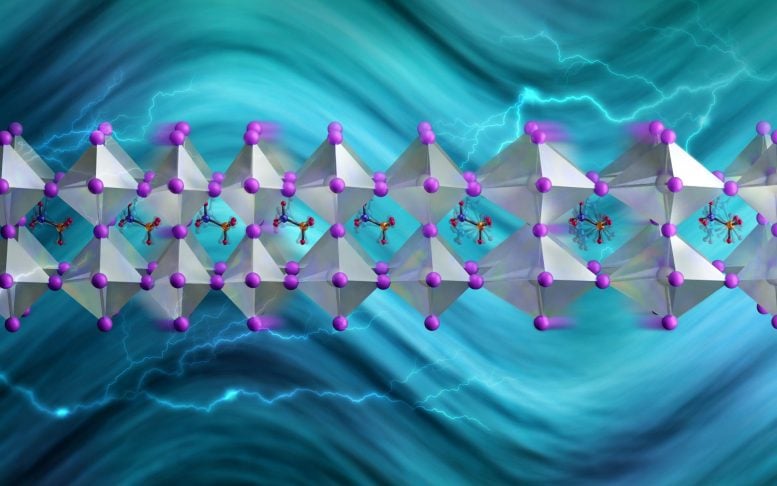Boosting Efficiency of Next-Gen Solar Cells by Blocking Vibrations That Remove

Substituting deuterium for hydrogen makes methylammonium heavier and slows its swaying so it can interact with vibrations that remove heat, keeping charge carriers hot longer. Credit: Jill Hemman/ORNL, U.S. Dept. of Energy
Led by the Department of Energy’s Oak Ridge National Laboratory and the University of Tennessee, Knoxville, a study of a solar-energy material with a bright future revealed a way to slow phonons, the waves that transport heat. The discovery could improve novel hot-carrier solar cells, which convert sunlight to electricity more efficiently than conventional solar cells by harnessing photogenerated charge carriers before they lose energy to heat.
“We showed that the thermal transport and charge-carrier cooling time can be manipulated by changing the mass of hydrogen atoms in a photovoltaic material,” said ORNL’s Michael Manley. “This route for extending the lifetime of charge carriers bares new strategies for achieving record solar-to-electric conversion efficiency in novel hot-carrier solar cells.”
UT’s Mahshid Ahmadi noted, “Tuning the organic-molecule dynamics can enable control of phonons important to thermal conductivity in organometallic perovskites.” These semiconducting materials are promising for photovoltaic applications.
Manley and Ahmadi designed and managed the study, published in Science Advances. Experts in materials synthesis, neutron scattering, laser spectroscopy and condensed matter theory discovered a way to inhibit wasteful charge cooling by swapping a lighter isotope for a heavier one in an organometallic perovskite.
When sunlight strikes a solar cell, photons create charge carriers — electrons and holes — in an absorber material. Hot-carrier solar cells quickly convert the energy of the charge carriers to electricity before it is lost as waste heat. Preventing heat loss is a grand challenge for these solar cells, which have the potential to be twice as efficient as conventional solar cells.
The conversion efficiency of conventional perovskite solar cells has improved from 3% in 2009 to more than 25% in 2020. A well-designed hot-carrier device could achieve a theoretical conversion efficiency approaching 66%.
The researchers studied methylammonium lead iodide, a perovskite absorber material. In its lattice, collective excitations of atoms create vibrations. Vibrations moving in sync with each other are acoustic phonons, whereas those moving out of sync are optical phonons.
“Typically, charge carriers first lose their heat to optical phonons, which propagate slower than acoustic phonons,” explained ORNL co-author Raphael Hermann. “Later, optical phonons interact with acoustic phonons that carry away this energy.”
However, in a region called the “hot phonon bottleneck,” exotic physics prevent electrons from losing their energy to collective vibrations that transport heat. To enhance this effect in a photovoltaic perovskite, the researchers used inertia, the tendency of an object to keep doing what it’s doing, be that resting or moving.
“We basically slowed down how fast the molecules can sway, similar to slowing a spinning ice skater by putting weights in her hands,” Hermann said.
To do that in an orderly atomic lattice, Ahmadi and ORNL’s Kunlun Hong led the synthesis of crystals of methylammonium lead iodide at the Center for Nanophase Materials Sciences, a DOE Office of Science User Facility at ORNL. They substituted a lighter isotope of hydrogen, normally occurring protium, which has no neutrons, with a heavier one, deuterium, which has one neutron, in the perovskite’s central organic molecule, methylammonium, or MA. Isotopes are chemically identical atoms that differ only in mass owing to the difference in neutron number.
Next, Manley and Hermann together with ORNL’s Songxue Chi conducted triple-axis neutron scattering experiments at the High Flux Isotope Reactor, a DOE Office of Science User Facility at ORNL, to map the phonon dispersion in protonated and deuterated crystals. Because they saw a disagreement between their measurements and published data from inelastic X-ray measurements, they made additional measurements at the Spallation Neutron Source, another DOE Office of Science User Facility at ORNL. There, Luke Daemen of ORNL used the VISION vibrational spectrometer to reveal all possible vibrational energies. The combined results indicated that longitudinal acoustic modes with short wavelengths propagate more slowly in the deuterated sample, suggesting thermal conductivity may be reduced.
Hsin Wang of ORNL performed thermal diffusivity measurements to investigate how heat moved in the crystals. “Those measurements told us that deuteration decreased the already-low thermal conductivity by 50%,” Manley said….
Read More: Boosting Efficiency of Next-Gen Solar Cells by Blocking Vibrations That Remove

